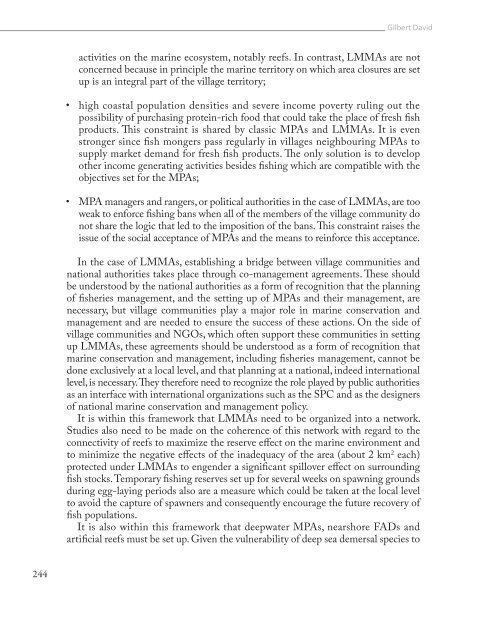Fisheries in the Pacific
Fisheries_in_the_Pacific
Fisheries_in_the_Pacific
Create successful ePaper yourself
Turn your PDF publications into a flip-book with our unique Google optimized e-Paper software.
Gilbert David<br />
activities on <strong>the</strong> mar<strong>in</strong>e ecosystem, notably reefs. In contrast, LMMAs are not<br />
concerned because <strong>in</strong> pr<strong>in</strong>ciple <strong>the</strong> mar<strong>in</strong>e territory on which area closures are set<br />
up is an <strong>in</strong>tegral part of <strong>the</strong> village territory;<br />
• high coastal population densities and severe <strong>in</strong>come poverty rul<strong>in</strong>g out <strong>the</strong><br />
possibility of purchas<strong>in</strong>g prote<strong>in</strong>-rich food that could take <strong>the</strong> place of fresh fish<br />
products. This constra<strong>in</strong>t is shared by classic MPAs and LMMAs. It is even<br />
stronger s<strong>in</strong>ce fish mongers pass regularly <strong>in</strong> villages neighbour<strong>in</strong>g MPAs to<br />
supply market demand for fresh fish products. The only solution is to develop<br />
o<strong>the</strong>r <strong>in</strong>come generat<strong>in</strong>g activities besides fish<strong>in</strong>g which are compatible with <strong>the</strong><br />
objectives set for <strong>the</strong> MPAs;<br />
• MPA managers and rangers, or political authorities <strong>in</strong> <strong>the</strong> case of LMMAs, are too<br />
weak to enforce fish<strong>in</strong>g bans when all of <strong>the</strong> members of <strong>the</strong> village community do<br />
not share <strong>the</strong> logic that led to <strong>the</strong> imposition of <strong>the</strong> bans. This constra<strong>in</strong>t raises <strong>the</strong><br />
issue of <strong>the</strong> social acceptance of MPAs and <strong>the</strong> means to re<strong>in</strong>force this acceptance.<br />
In <strong>the</strong> case of LMMAs, establish<strong>in</strong>g a bridge between village communities and<br />
national authorities takes place through co-management agreements. These should<br />
be understood by <strong>the</strong> national authorities as a form of recognition that <strong>the</strong> plann<strong>in</strong>g<br />
of fisheries management, and <strong>the</strong> sett<strong>in</strong>g up of MPAs and <strong>the</strong>ir management, are<br />
necessary, but village communities play a major role <strong>in</strong> mar<strong>in</strong>e conservation and<br />
management and are needed to ensure <strong>the</strong> success of <strong>the</strong>se actions. On <strong>the</strong> side of<br />
village communities and NGOs, which often support <strong>the</strong>se communities <strong>in</strong> sett<strong>in</strong>g<br />
up LMMAs, <strong>the</strong>se agreements should be understood as a form of recognition that<br />
mar<strong>in</strong>e conservation and management, <strong>in</strong>clud<strong>in</strong>g fisheries management, cannot be<br />
done exclusively at a local level, and that plann<strong>in</strong>g at a national, <strong>in</strong>deed <strong>in</strong>ternational<br />
level, is necessary. They <strong>the</strong>refore need to recognize <strong>the</strong> role played by public authorities<br />
as an <strong>in</strong>terface with <strong>in</strong>ternational organizations such as <strong>the</strong> SPC and as <strong>the</strong> designers<br />
of national mar<strong>in</strong>e conservation and management policy.<br />
It is with<strong>in</strong> this framework that LMMAs need to be organized <strong>in</strong>to a network.<br />
Studies also need to be made on <strong>the</strong> coherence of this network with regard to <strong>the</strong><br />
connectivity of reefs to maximize <strong>the</strong> reserve effect on <strong>the</strong> mar<strong>in</strong>e environment and<br />
to m<strong>in</strong>imize <strong>the</strong> negative effects of <strong>the</strong> <strong>in</strong>adequacy of <strong>the</strong> area (about 2 km 2 each)<br />
protected under LMMAs to engender a significant spillover effect on surround<strong>in</strong>g<br />
fish stocks. Temporary fish<strong>in</strong>g reserves set up for several weeks on spawn<strong>in</strong>g grounds<br />
dur<strong>in</strong>g egg-lay<strong>in</strong>g periods also are a measure which could be taken at <strong>the</strong> local level<br />
to avoid <strong>the</strong> capture of spawners and consequently encourage <strong>the</strong> future recovery of<br />
fish populations.<br />
It is also with<strong>in</strong> this framework that deepwater MPAs, nearshore FADs and<br />
artificial reefs must be set up. Given <strong>the</strong> vulnerability of deep sea demersal species to<br />
244


